*This page may include affiliate links, which means that if you make a purchase through one of the product links, we may receive a small commission. For full affiliate disclosure please see our disclaimer page.
As a loving pet owner, ensuring the well-being and comfort of your furry friend is always a top priority. One essential but often overlooked aspect of dog care is nail maintenance. You might be wondering, “How much is too much when it comes to grinding my dog’s nails?” or “How can I ensure I don’t hurt my pet in the process?” You’re not alone in these concerns. This blog aims to shed light on the often murky waters of dog nail care, specifically addressing the pivotal question: When to stop grinding dog nails? Dive in as we unpack the signs to watch out for and provide handy tips to avoid the quick – ensuring a safe and painless grooming experience for your four-legged companion.
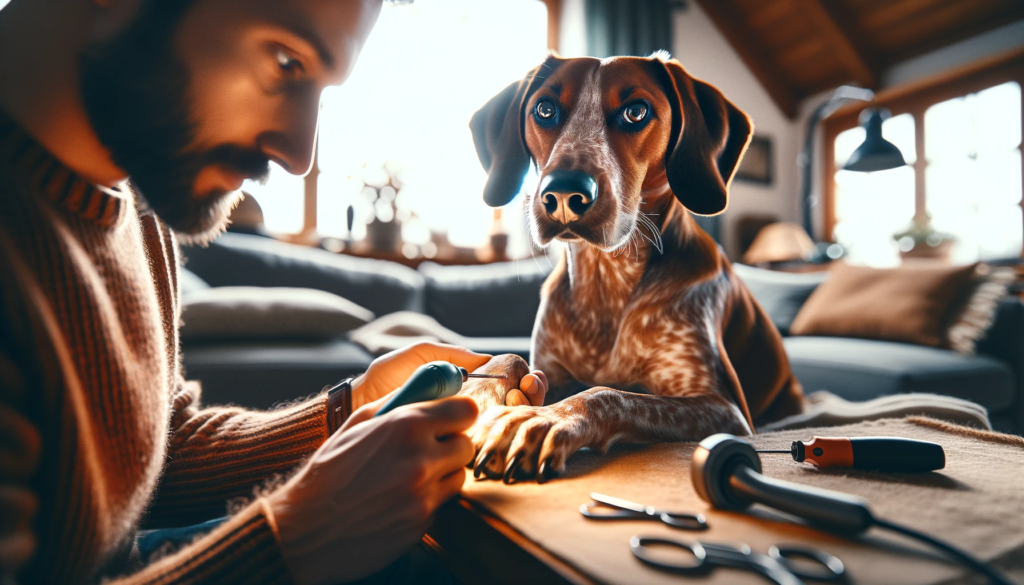
How to Avoid Failures While Cutting Your Dog’s Nails
Ensuring your dog’s nails are well-maintained is more than just aesthetics; it’s about health, comfort, and safety. However, it can be an intimidating process for both owners and their pets. Let’s explore methods to make this process smoother and more efficient, minimizing any potential mishaps.
Cut Your Dog’s Nails Regularly
- Regular maintenance reduces the chances of the nails growing too long.
- Shorter intervals between trims mean less stress for your dog as they become familiar with the routine.
- It prevents nails from becoming overly curved, which can lead to painful ingrown nails.
Use an Electric Pet Nail Grinder
- Nail grinders minimize the risk of cutting into the quick.
- They give a smoother finish compared to traditional clippers.
- Grinders are especially beneficial for dogs with thicker nails that are difficult to cut.
Choose the Right Moment for Cutting Your Dog’s Nails
- Opt for a time when your dog is calm, perhaps after exercise or a meal.
- Avoid nail trimming when your dog is overly excited or anxious.
- Create a calm environment, free from loud noises or other distractions.
Ease your Pet into Paw Handling
- Regularly touch and massage your dog’s paws, so they become accustomed to handling.
- Reward your dog with treats or praise when they allow you to handle their paws.
- Gradually introduce nail cutting tools without actually using them, so your dog gets familiar with them.
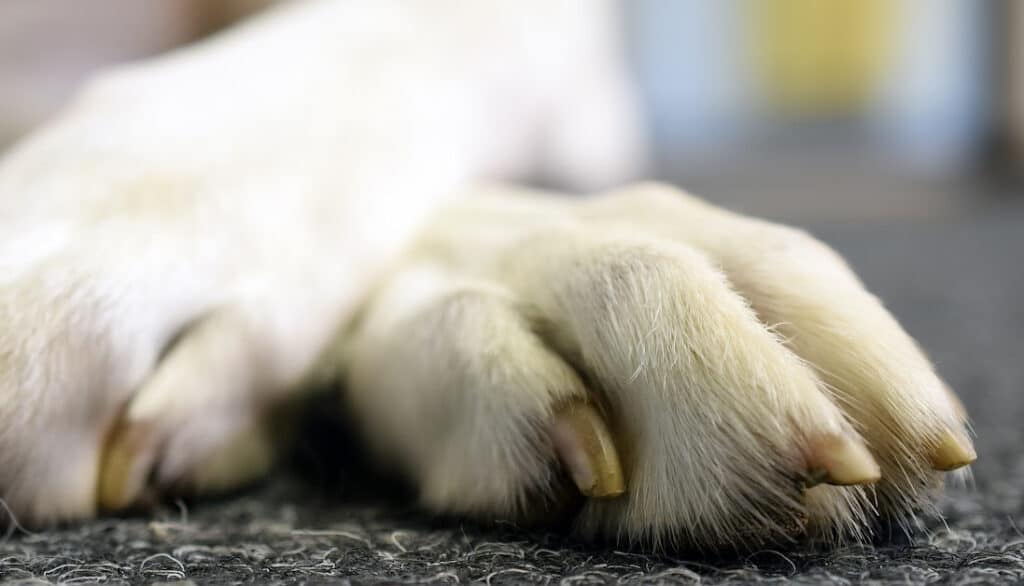
Introduce the Electric Pet Nail Grinder
- Start by simply letting your dog sniff and explore the grinder.
- Turn on the grinder away from your dog initially, so they get used to the sound.
- Reward your pet with treats and praise for calm behavior around the grinder.
Have Some Styptic Powder to Hand
- Accidents happen. Styptic powder quickly stops bleeding if you accidentally cut into the quick.
- Always keep it nearby during nail trimming sessions.
- If you don’t have styptic powder, cornstarch can also be effective in a pinch.
Hold the Paw Firmly When Cutting Your Dog’s Nails
- A firm grip ensures stability and prevents sudden movements.
- However, be gentle. Too much pressure can make your dog uncomfortable.
- Holding the paw up, rather than out to the side, can often give you a better angle for trimming.
Hold the Tool at a 45-Degree Angle
- Holding at this angle helps avoid cutting into the quick.
- It offers a cleaner cut or grind.
- Regularly check the nail’s progress, ensuring you don’t trim too much at once.
Praise and Reward After Each Session
- Always end each nail-trimming session on a positive note.
- Offer treats, verbal praises, or playtime as a reward for their patience and good behavior.
- This positive reinforcement encourages better cooperation in subsequent sessions.

Stay Calm and Patient
- Your dog can sense your emotions. If you’re anxious or stressed, your dog will pick up on that, making them nervous as well.
- Take deep breaths if you feel overwhelmed. Remember, you can always take a break and return to the task later.
- If you’re uncertain, consider observing a professional groomer or veterinarian the first few times. This hands-on learning can help boost your confidence.
Educate Yourself
- Continuously educate yourself about your specific dog breed. Some breeds have unique nail considerations.
- Watch videos, attend workshops, or consult with your vet regularly for nail-trimming tips.
- The more you know, the better equipped you’ll be to handle unexpected situations.
Regularly Check the Tools
- Ensure that your tools, be it clippers or grinders, are sharp and in good working condition.
- Dull tools can split or crack the nail, causing pain and discomfort.
- Clean your tools after each session to maintain hygiene and prolong their life.
Seek Professional Help When Needed
- If you ever feel uncertain or uncomfortable cutting your dog’s nails, there’s no shame in seeking professional help.
- Professional groomers and vets have experience with various breeds and nail types.
- Occasionally having your dog’s nails trimmed by a professional can also provide you with a benchmark for future at-home trims.
By following these guidelines and remaining patient, nail trimming can become a stress-free routine for both you and your pet. Remember, it’s always okay to take breaks and return to the task if your dog becomes overly anxious. Safety and comfort are paramount.
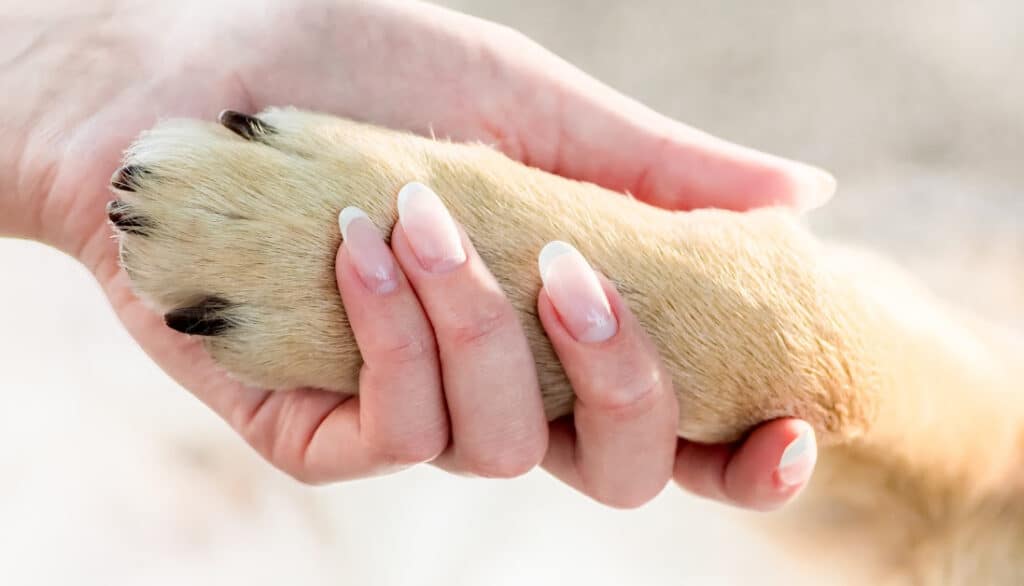
How Do You Know When to Stop Grinding Your Dog’s Nails?
Grinding your dog’s nails is an effective alternative to traditional clipping, offering precision and minimizing risks. However, it’s essential to know when to stop to ensure your dog’s safety and comfort. Let’s delve into the indicators and tips that signal it’s time to halt the grinding process.
Watch for the White Ring
- As you grind closer to the quick, a small white ring or dot will start to appear in the center of the nail.
- This white ring indicates that you are approaching the quick and should stop soon.
- For dogs with darker nails, this can be more challenging to spot, so proceed with caution.
Check the Nail Temperature
- Continuous grinding can generate heat, causing discomfort to your dog.
- If the nail feels warm to the touch, it’s a good idea to give it a break before continuing.
- Your dog might also pull their paw away or show signs of discomfort due to the heat.
Observe Your Dog’s Behavior
- Dogs will often give signs when they’re uncomfortable. They might try to pull their paw away, whine, or show signs of distress.
- If your dog starts to show discomfort or anxiety, it might be time to pause or stop the grinding process.
Feel the Nail Thickness
- As you grind, periodically feel the nail’s thickness between your fingers.
- When the nail feels considerably thinner and more pliable, you are likely nearing the quick.
Stay within Safe Lengths
- Always maintain a conservative length when grinding your dog’s nails.
- It’s safer to err on the side of slightly longer nails than to risk injuring the quick.

Consistent Check-ins
- Regularly check the progress of the nail as you grind.
- Pause every few seconds, especially as you get closer to the desired length, to ensure you don’t overdo it.
Use a Flashlight for Dark Nails
- For dogs with black or dark-colored nails, shining a flashlight from underneath the nail can help in identifying the quick.
- The quick will appear as a darker shadow within the nail, signaling that you’re nearing your stop point.
Consult with a Professional
- If you’re ever uncertain about how much to grind, consider a consultation with a professional groomer.
- They can provide guidance on safe lengths for your dog’s specific breed and nail type.
In essence, understanding when to stop grinding your dog’s nails revolves around observation, gentle touch, and a good sense of your pet’s comfort. With practice and patience, you’ll become more adept at recognizing these signs, ensuring a safe and stress-free experience for both you and your furry friend.
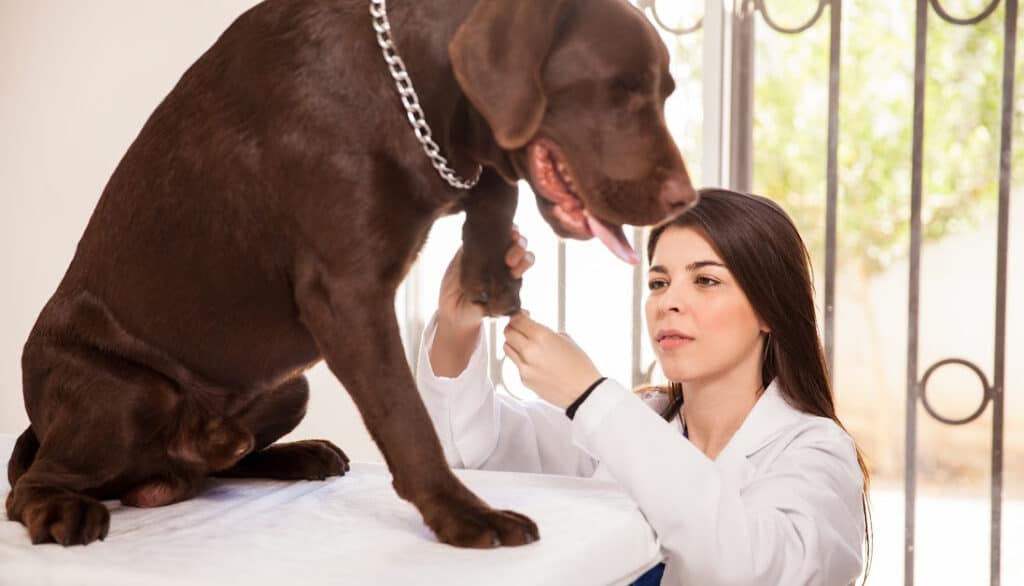
How Often Should You Grind Dog’s Nails?
Regular nail maintenance is vital for your dog’s health and comfort. While the frequency of grinding can vary based on several factors, establishing a consistent routine is essential. Here’s a comprehensive guide on determining how often you should grind your dog’s nails.
Activity Level and Lifestyle
- Active Dogs: Dogs that are frequently active, especially on hard surfaces like concrete, naturally wear down their nails. These dogs might need less frequent nail grinding.
- Indoor Dogs: Dogs that spend most of their time indoors on soft surfaces like carpets won’t wear their nails down naturally. They typically require more regular nail grinding.
Nail Growth Rate
- Every dog is unique. Some dogs have nails that grow faster than others. Regularly check the nail length to determine the appropriate grinding frequency.
Age of the Dog
- Puppies: Puppy nails grow very quickly. You might find that younger dogs require more frequent nail grinding.
- Senior Dogs: Older dogs might be less active, leading to less natural wear of their nails. Regular checks and possibly more frequent grinding sessions might be needed.
Type of Nail
- Hard Nails: Breeds with harder nails might not wear them down as quickly through regular activity. Such breeds often benefit from more frequent grinding.
- Soft Nails: Soft nails tend to wear down or break naturally but still require consistent check-ups to ensure they’re at a comfortable length.
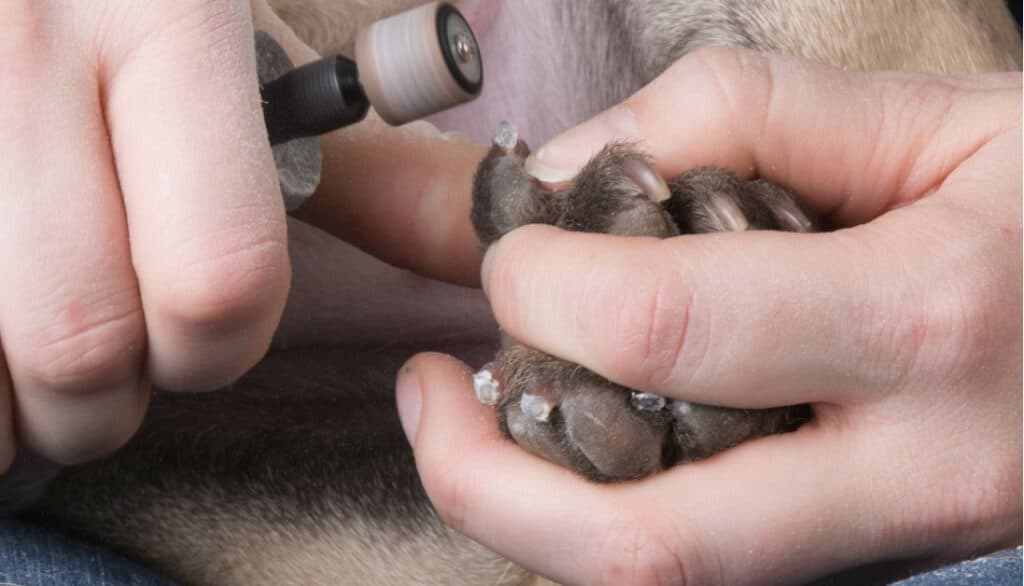
General Guidelines
- Weekly to Bi-weekly: For most dogs, checking the nails weekly and grinding every two weeks is a good starting point.
- Monthly: For dogs that naturally wear down their nails or have slower nail growth, a monthly check and grind might suffice.
Visual and Audible Checks
- If you hear your dog’s nails clicking on the floor when they walk, it’s usually a sign that their nails are too long and need grinding.
- Visually inspect the nails. If they seem overly curved or long, it’s time for a grind.
Safety First
- It’s always better to grind a little bit more often than to wait too long and risk the quick growing out with the nail. Longer nails can also cause discomfort or lead to other issues like ingrown nails or impaired walking.
Post Grinding Check
- After grinding, if you notice your dog’s nails still touch the ground when they’re standing, you’ll know to adjust your routine accordingly.
While there are general guidelines, the exact frequency of nail grinding depends largely on your dog’s individual needs. It’s essential to strike a balance between their natural lifestyle and the need for regular grooming. By staying attentive to your dog’s nails and adjusting based on their specific conditions, you’ll ensure their paws stay healthy and comfortable.
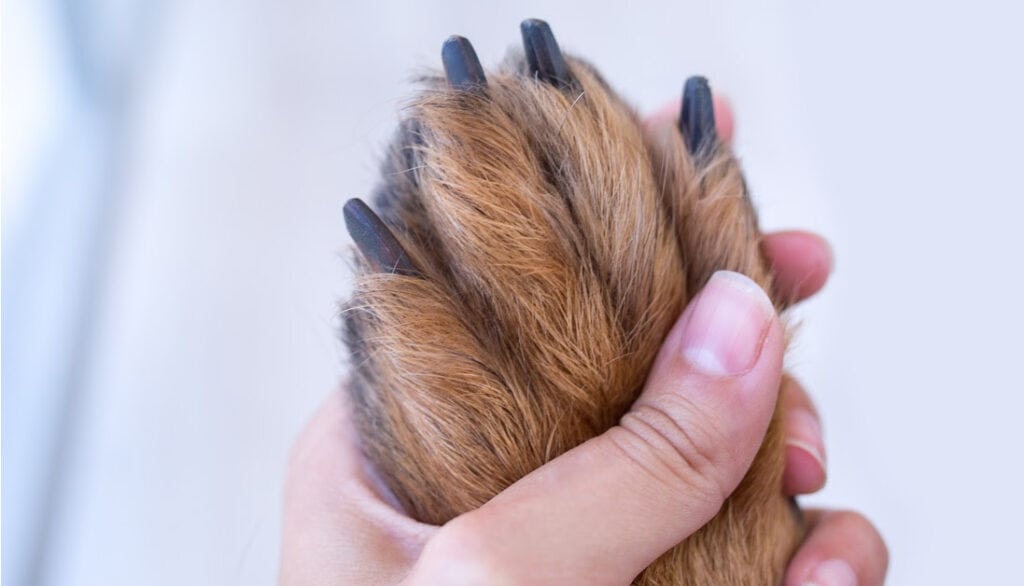
Does Grinding Dogs Nails Hurt Them?
It’s a common concern among pet owners: Will grinding my dog’s nails cause them pain? In essence, when done correctly, grinding your dog’s nails is a safe and effective method of nail maintenance that should not cause any pain. However, there are nuances to consider. Let’s explore the matter in-depth.
The Advantages of Grinding
- Smooth Finish: Grinding provides a smoother finish to the nail compared to clipping. This reduces the chance of nails snagging on surfaces or splitting.
- Precision: Grinders offer more control, which allows for a gradual reduction of the nail’s length, minimizing the risk of cutting into the quick.
- Less Pressure: Unlike clippers that exert sudden pressure, grinders gently wear down the nail, which can be more comfortable for some dogs.
Potential Sources of Discomfort
- Heat: Continuous grinding can create friction, which produces heat. If the nail gets too hot, it can be uncomfortable for the dog.
- Vibration: Some dogs might be sensitive to the vibration caused by the grinder. This sensation can feel odd but typically doesn’t cause pain.
- Noise: The sound of the grinder can be unsettling for some dogs, leading to anxiety. While this isn’t physical pain, mental distress is worth noting.
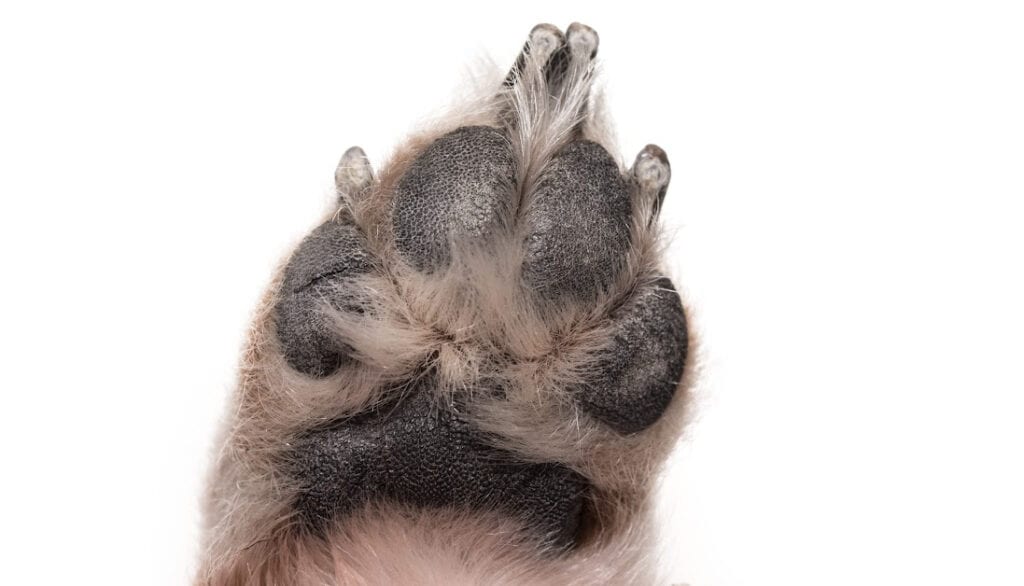
The Quick
The quick is a sensitive part of the nail containing nerves and blood vessels.
- Grinding Too Deep: Just like cutting, if you grind into the quick, it will cause pain and bleeding. However, the gradual nature of grinding often gives you more reaction time to stop before reaching the quick.
- Recognizing the Quick: As you approach the quick, a small white or grayish ring or dot will often appear in the center of the nail. It’s a signal to stop grinding.
Ensuring a Painless Experience
- Regular Maintenance: Regular nail grinding ensures the quick doesn’t extend too much, making the process easier and reducing chances of injury.
- Training and Familiarity: Gradually introducing your dog to the grinder, its noise, and sensation can make the experience less stressful.
- Short Sessions: Instead of grinding each nail down in one go, it might be less stressful to do a little bit on each nail and then cycle through them again. This method can also help avoid generating too much heat on a single nail.
- Equipment Quality: A good quality grinder with multiple speed options allows for better control and can be gentler on the dog’s nails.
Professional Consultation
If you’re uncertain or your dog seems particularly averse to the grinding process, it might be a good idea to consult a professional groomer or vet. They can provide guidance, tips, and even demonstrations.
When done correctly and with the dog’s comfort in mind, grinding your dog’s nails should not cause them pain. Like any grooming process, it requires patience, understanding, and a bit of practice to ensure a positive experience for both you and your pet.
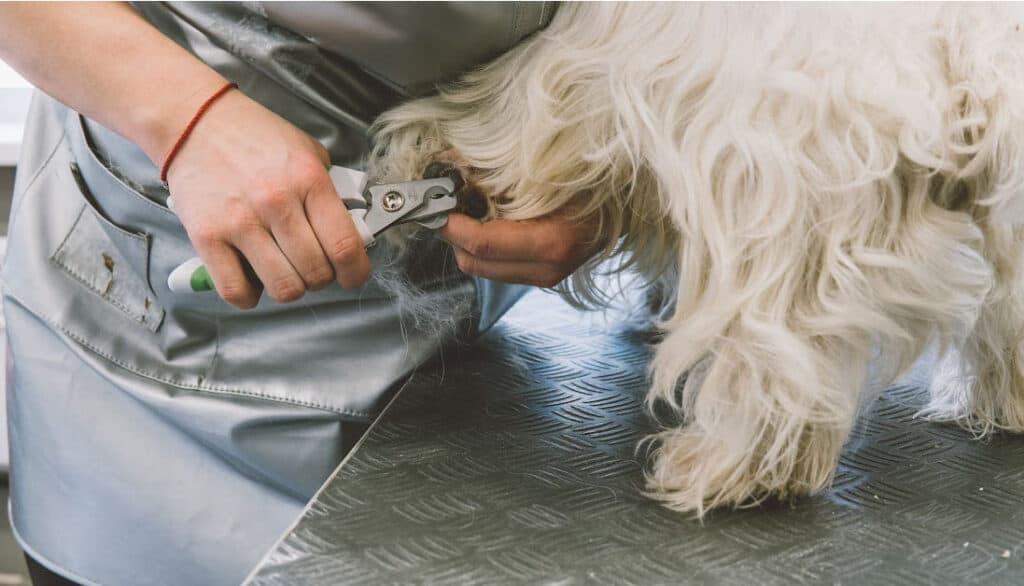
What Shape Should Dog Nails Be to Grind?
Grinding is an effective method for maintaining a dog’s nails, but it’s crucial to know the ideal shape and length to aim for during the process. The shape of a dog’s nails can significantly impact their comfort and overall paw health. Let’s delve into the desired nail shape and how to achieve it through grinding.
Natural Curve
- Dog nails naturally have a curve, and it’s essential to respect this natural shape when grinding.
- Over-grinding or flattening the curve can lead to discomfort and may cause the nail to grow unnaturally.
Avoiding Overextension
- Nails that are too long can cause discomfort when walking, leading to posture issues and potential injuries.
- Ideally, when your dog is standing on a flat surface, their nails shouldn’t touch the ground. If they do, it’s an indication they might be too long.
Rounded Tips
- One of the benefits of grinding versus clipping is the ability to achieve a smooth, rounded finish at the tip.
- Rounded tips prevent nails from snagging on carpets, clothes, or other surfaces and reduce the risk of accidental scratches.
Maintain a Gradual Taper
- When grinding, work the nail to create a gentle taper from the base to the tip.
- A gradual taper respects the nail’s natural shape and ensures the strength and integrity of the nail.
Avoiding the Quick
- The quick, a sensitive vein inside the nail, dictates how short you can safely grind the nail.
- Aim to grind the nail close to, but not touching, the quick. For clear nails, the quick is visible as a pinkish area. For darker nails, watch for a small white ring or dot which indicates you’re approaching the quick.
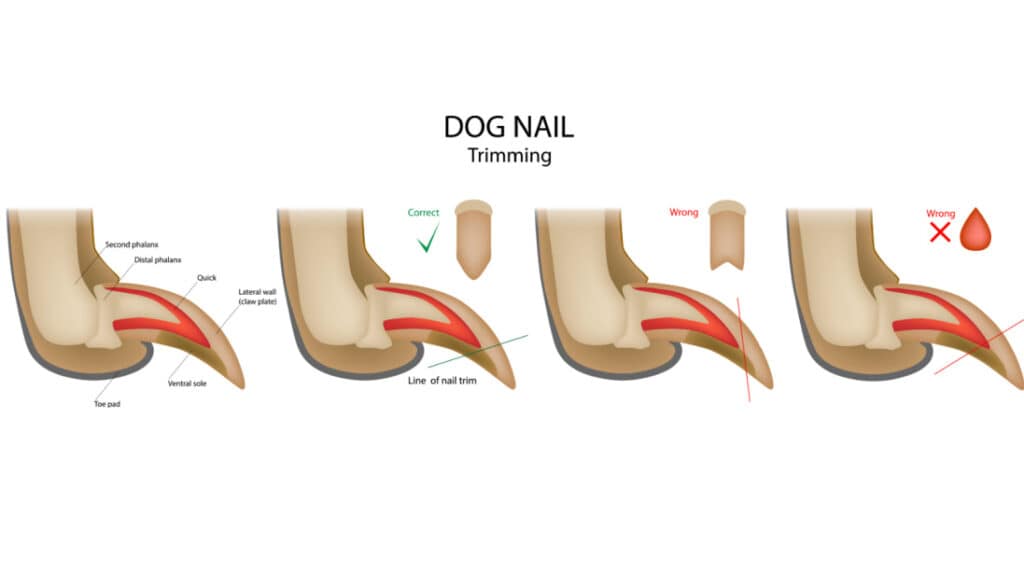
Checking from Different Angles
- Periodically, pause and inspect the nail from various angles. This approach ensures even grinding and helps you achieve a consistent shape across all nails.
Flat Base with a Curved Top
- Think of the ideal nail shape as a semi-circle. The base (where it connects to the paw) should be relatively flat, while the upper part maintains a natural curve.
Feedback from Your Dog
- Dogs often indicate when something doesn’t feel right. If your dog starts to pull away or shows signs of discomfort, it may be an indication that you need to adjust the shape or check your grinding technique.
Regular Checks and Maintenance
- Frequent checks will help you identify when it’s time to grind again. Regular maintenance ensures that the nails remain in the ideal shape, making each grinding session simpler and faster.
In summary, the goal when grinding your dog’s nails is to emulate and maintain their natural shape, ensuring comfort, and avoiding any potential health issues. With patience and practice, you can master the technique, ensuring that your dog’s nails are in the best possible shape for their health and well-being.
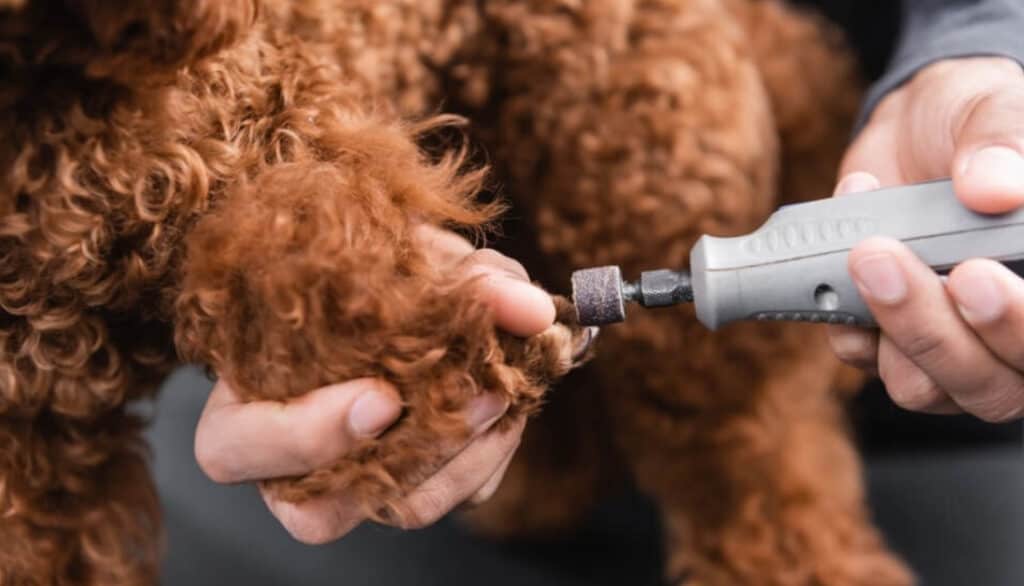
Conclusion
Taking care of your furry friend extends beyond just feeding and regular walks. The often overlooked practice of nail maintenance plays a pivotal role in their comfort and overall health. While the process of grinding might initially seem daunting, with the right knowledge, tools, and a gentle approach, it becomes a straightforward task. By understanding the nuances—like when to stop grinding, how often to do it, what shape to aim for, and ensuring it’s a pain-free experience—you’re not just trimming nails; you’re paving the way for a happier, healthier pet.
Every moment spent in this endeavor also serves to strengthen the bond between you and your canine companion. They learn to trust you even more, recognizing the care and love behind each action. So, as you embark on this journey of regular nail care, remember that with each grind, you’re not just shaping a nail, but also fostering trust and ensuring your pet’s pawsitive well-being. Happy grinding!
Frequently Asked Questions (FAQs)
A: Yes, you can switch between methods depending on your comfort level and your dog’s tolerance. Some dog owners clip the nails first to achieve the desired length and then use a grinder to smooth out the edges. It’s essential to ensure your dog is comfortable with both processes and to be especially cautious not to cut or grind too close to the quick.
A: Each dog is different. Some might become accustomed after a few sessions, while others may take longer. It’s crucial to introduce the grinder gradually, letting your dog get used to its sound and vibration. Starting with short sessions and providing treats and praise can help make the experience more positive.
A: First, remain calm. While it can be distressing, accidents happen. Have styptic powder or a styptic pencil on hand; these can help stop the bleeding when applied to the nail. If you don’t have these, you can also use cornstarch or flour in a pinch. If the bleeding continues for an extended period or seems excessive, contact your veterinarian.
A: Look for grinders that have multiple speed settings, which allow for better control. It’s also beneficial to choose a grinder with a safety guard to reduce the chances of grinding too deeply. Reading reviews and consulting with your veterinarian or a professional groomer can provide additional recommendations tailored to your dog’s specific needs.
A: In cases of extreme anxiety, it’s essential to prioritize your dog’s well-being. You can try alternative methods like clipping or consult a professional groomer who may have techniques and tools to make the process more comfortable. It might also be helpful to consult with your vet about possible calming treatments or techniques that can make nail grooming more manageable.
